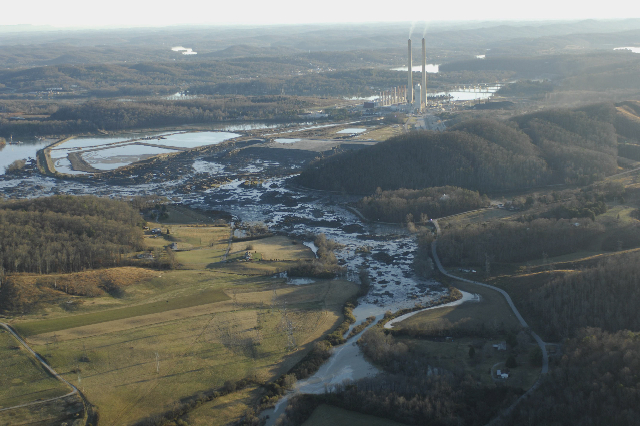TVA coal ash slide – UPDATES
December 27th, 2008
The only good news in this is that the media is picking this up, it’s not going to be “disappeared.”
From the “field” or from the slime, muck & yuck, here are updates. Special thanks to United Mountain Defense, John Walthen, Nicholas Mann, Tom Swinford, Chris Irwin, Donna Lisenby, Dot Griffith, and all those doing tremendous work getting the word and pictures out (whose names haven’t shown up in the emails I’ve received). This is a clear example of the importance of the internet.
Here’s from The Tennessean:
Would you believe 5.4 million cubic yards? Can you even imagine that?
A video from the scene by people taking water samples on the Emory River:
There is a great collection of photos on Photobucket:
A general view of the devastation, being downplayed by TVA and the coal industry:
Here you can watch the cops clearing out the area (at the end), can’t have this showing up on YouTube, don’t cha know:
And this photo by Dot Griffith puts it all together:
Otter Tail “has no objection”
June 5th, 2008
Otter Tail’s David Sasseville (Lindquist & Vennum) said that they had no objection to administrative of their filings of June 3, 2008. What else did he have to say? Here’s his missive after I filed the mncoalgasplant.com Motion for Disclosure & Commission Notice; Exhibit A – Otter Tail Power 8k filing to, duh, have the filing disclosed and for Official Notice by the Public Utilities Commission:
This reply is submitted on behalf of the Big Stone II Applicants, and that project’s lead developer, Otter Tail Power Company. Ms. Overland’s communication to the Commission and the parties in the Big Stone II transmission docket regarding Otter Tail’s filing yesterday was inappropriate and unnecessary. Otter Tail has not formed a holding company and has not reorganized. Rather, it merely filed applications yesterday in Minnesota, the Federal Energy Regulatory Commission, North Dakota and South Dakota for permission to form a holding company. The SEC filing referenced by Ms. Overland merely reflects the fact that Otter Tail is seeking permission to form a holding company. Whether that ultimately occurs, and whether and how Otter Tail’s organizational structure changes, will be resolved in the context of the FERC, SDPUC and NDPSC dockets, and the MPUC docket that was created yesterday (No. PA-08-658). Under no circumstances will yesterday’s filing have an impact on the Big Stone II docket, or on Otter Tail’s ability to proceed with its obligations and commitments in that docket. Otter Tail’s filing is available electronically at the PUC’s web site. In addition, Ms. Overland and/or MNCoalgasplant.com may add their names to the mailing list in the docket to receive future filings in the matter. David L. Sasseville Lindquist & Vennum P.L.L.P. 4200 IDS Center 80 South Eighth Street Minneapolis, MN 55402 612/371-3237 612/371-3207 (fax)
Yes, the filing is NOW available on the PUC eDockets site. Go to www.puc.state.mn.us and then to “eDockets” on the left, and then to “Search Documents” and search for 08-658. Inappropriate and unnecessary? When the parties are making final arguments in the Big Stone II case and Commission is making a decision, it’s fully appropriate to nail down disclosure and notice by the Commission … sigh… and here’s my response:
Mr. Sasseville and all: It is my belief and the purpose of this Motion that: 1) this filing should be formally disclosed within the Big Stone II proceeding by Otter Tail Corporation/Otter Tail Power (as of your missive, it now has been acknowledged); and 2) this filing should receive Official Notice in the Big Stone II deliberation by the Public Utilities commission. It is unknown whether there will be any impact, and the Motion does not address substantive issues of the reorganization nor suggest that substantive issues be addressed in the Big Stone docket, just that it should be disclosed and receive Official Notice of the Commission. Carol A. Overland for mncoalgasplant.com
To which he responded:
Ms. Overland: Your email implies that the Otter Tail filing portends something the Commission should be aware of, but isn’t, and that such information is a matter of actual or potential significance to the proper determination of the Big Stone II Transmission Certificate of Need and Route Permit proceeding tomorrow. While these implications are unfounded, the Big Stone II Applicants, including Otter Tail, have no objection to the Commission taking administrative notice of any and all docket filings in matters before it, including Otter Tail’s June 3, 2008 filing, and assigning whatever weight to those filings it believes is appropriate.
Well, that’s good, “the Big Stone II Applicants, including Otter Tail, have no objection to the Commission taking administrative notice of any and all docket filings in matters before it, including Otter Tail’s June 3, 2008 filing…” which is the entire point! Get it out there in the open…
Otter Tail Corporation’s News Release Page – do you see a press release about this filing?
…so then I says:
Mr. Sasseville – My concern, again, is twofold, first, that Otter Tail disclose the fact of the filings to the Commission and the parties (I do not believe this had been done prior) and it should be in the record, and second, that the Commission take administrative notice of these filings. That’s all. Because you state that “the Big Stone II Applicants, including Otter Tail, have no objection to the Commission taking administrative notice of any and all docket filings in matters before it, including Otter Tail’s June 3, 2008, filing,” I trust that disclosure and a statement that Otter Tail has no objection will occur.. Thank you for your statement of Otter Tail’s position. Carol for mncoalgasplant.com
And so what happened at the deliberation, what’s happening right now? Who knows… Was this addressed? Who knows…
Woodbury has the right idea — utility tax
November 26th, 2006
Now here’s a way that local governments can deal with the utilities pulling the rug out from under them by cutting, recalculating, suing, and whatever else they can think of to eliminate the utility personal property tax that provides siginifcant revenue. Red Wing is in the midst of doing a deal with Xcel about utility personal property tax, as is Goodhue County — why isn’t the entire state instituting this instead of caving? I’ve got to dig up some papers in this pile, but that means getting the Exhibits done for Mesaba… finishing my testimony & Exhibit chart, so in short, it’ll be later rather than sooner, but this article has to get out there for consideration:
City wants $750,000 in added yearly revenue
BY STEVE SCOTT
Pioneer PressMaplewood is negotiating with Xcel Energy on the details of an increased electric tax that would produce $750,000 in additional annual revenue for the city, municipal officials say.
As it does in several metro-area cities, Xcel collects what the city calls a monthly franchise tax from all electric users, at the city’s request, and passes the money along to the city.
Xcel has collected such a tax for Maplewood since 2005, but the city is seeking more than a fivefold increase for 2007.
“We’ve always looked at this as a way to reduce property taxes,” City Manager Greg Copeland said.
“We have 133 properties in Maplewood that are tax-exempt (such as schools, churches and railroads). What we are hoping to do is collect some additional revenue from these entities from the franchise tax.”
Because the electric tax is spread out over every utility user in the city, not just property owners, Maplewood officials plan for that increase to reduce next year’s anticipated property tax increase from 11.4 percent to 6.4 percent.
The increased electric tax, however, would be applied across the board to residential customers, small businesses and large commercial and industrial accounts.
For example, the city’s residential customers, who now pay a franchise tax of 50 cents a month, would pay a proposed $2.70 a month.
City officials say the increased electric tax would equate to property tax savings ranging from $1.80 a year on a $150,000 home to $43.80 a year on a $400,000 home.
Many of the nearly 20 residents who spoke out on the issue at last week’s City Council meeting were skeptical.
“This is like putting two quarters in my left pocket â?¦ by taking two quarters out of my right pocket,” John Gores said.
Some residents questioned why residential and commercial customers would be assessed the same percentage increase. Small-business accounts paying a monthly electric tax of $1 to $6 would pay a proposed $5.40 to $32.40. Large commercial accounts would pay $243, up from $45.
Other residents asked why the electric tax wouldn’t be prorated among property owners according to energy usage.
“Flat taxes like this are extremely regressive,” William Robbins said. “If these taxes might be collected, I would hope it would be with fairness and equity.”
Colette Jurek, government relations manager for Xcel, said the company’s policy since 2000 has been to assess a flat tax.
“Our company believes a customer’s energy consumption is not proportionate to the amount of city services they use in a month,” she said.
City officials agreed with some of the residents’ objections but said Xcel would have to agree to any changes. Mayor Diana Longrie moved to table the issue to allow the city to negotiate with Xcel for “a more proportionate tax rate.”
Because of that delay, it’s likely an increase would not take effect until March.
The city indicated it would apply the revenue from an electric tax increase toward utility charges at city buildings, including the Community Center; street lighting; utility right-of-way maintenance; energy conservation projects; and weatherization of low-income homes.
Steve Scott may be reached at 651-228-5526 or sscott@pioneerpress.com.
Is Utility Personal Property Tax Deal a Deal?
November 11th, 2006

Letter: Will Xcel deal preserve our fair share?
Carol Overland, Red Wing, The Republican Eagle
Published Saturday, November 11, 2006
To the Editor:
Decades ago, NSP built the Prairie Island plant, and it was welcomed in large part because of the economic benefits.
Tax revenue for this plant has been slashed by over 60 percent in the last decade. What happened to that deal?
There’s a new utility personal property tax deal between Xcel, Goodhue County and Red Wing. Is this a good thing? I’ve represented clients who’ve successfully preserved their tax base. I’ve also represented parties regarding NSP/Xcel deals because my clients suffered consequences, i.e., the “stick it to Goodhue County” nuclear waste in Florence Township, the Chisago transmission line redesigned at twice the capacity originally proposed, the TRANSLink deal and its codification as the 2005 Transmission bill which brings three 345kV transmission lines to Red Wing. I’m skeptical of any deal.
Utility personal property tax is an arcane tax paid by all utilities owning infrastructure to all local governments across the state. All jurisdictions are affected by the 60-percent tax rate cuts.
These cuts were a peripheral issue in the campaign: Candidates were asked about the dwindling tax base, but not what they would do to restore revenue. Only one spoke about her successful experience in negotiating with the utility. Potential solutions range from influencing the Department of Revenue rule change; stepped restoration of utility tax rates; production tax on all generation; elimination of blanket exemptions coupled with a Host Fee Agreement. Local governments must act in concert. Will they?
That’s my concern. This community has been held hostage by a “good neighbor” utility which showed its appreciation for the 1994 lobbying effort “to protect the tax base” by gutting that base as local governments cower. What’s encouraging is that there’s recognition that it’s time to protect our interests. What’s Xcel going to do if challenged, take its nuclear plant and go?
Those working on this deal have pledged to act to protect the tax base and made strenuous assurances that this deal is premised on legislative change. This deal is “a floor, not a ceiling” to preserve the status quo while legislative efforts go forward. That’s reasonable to restore the diminishing tax base, whether legislatively, administratively, or legally, is to enforce the original premise. We’ve got to support local government in its fight to preserve our fair share.
Carol Overland
Red Wing
Revenue Stabilization Agreement
October 27th, 2006

I have this feeling about the proposed deal between Red Wing and Xcel. It’s been in the works for a year and a half now, and is due to be approved. It was on the last Council meeting agenda until I raised this little problem — the copy on-line was missing all the odd pages, and it’s hard to comment on something that you can’t read! So they did continue that…
In the meantime, now I’m starting to go over this and there are a few things that jump out.
1) The “valuation” of the property, a 1,060MW plant, is listed at $400,000, which is 1/4 of the cost of the 600MW Big Stone II plant. It seems at minimum, it should be twice that. Apparently valuations can be challenged, and ARE challenged because they’re regarded as arbitrary, there’s not a concrete formula used. Valuation is in the Tax Statements in the Exhibit, and can also be found using the PIN at the County site. Go to Property Information and then Property Tax Information (but I’m getting “ERROR”).
2) There’s this out for large capital expenditures. Extraordinary Investments, para. 7. Ummm… this is an aging plant, and is in the process of being refurbished, and it seems it will be, in large part, prior to relicensing. Steam Generator I has been replaced, and Steam Generator II is on the way (or done?), turbines are going to be replaced, and it seems that by not counting the increase in value, what they’re doing is restoring the major components and then those would not be included in the valuation. Sure, that’s good for Xcel, but what does it do for us? They’ll end up with a like-new plant with a $400,000 “value.” Because there is an exemption for these costs, those agreeing to this deal should have a replacement schedule with costs, so they know what they’re waiving. It seems to me that if this agreement was not in place, the valuation would rise, the gross valuation would rise with these expensive replacements, even if the rate itself goes down.
3) Isn’t there an inherent value in relicensing and in avoided costs when they can use this plant and not build another? Like avoiding costs of around $3 billion, using Big Stone as a guide?
4) Though the agreement is predicated on continued legislative efforts to restore the tax revenue, through any number of means, and the agreement allows for these continued efforts, assumes it, yesterday Sen. Steve Murphy was very clear that he had no intent on addressing this legislatively, “that would be going backwards.” If his constituents are counting on his help on this, on his supporting them and not his employer, Xcel, we have a problem here.

There are a few things to weigh. I would guess that what Xcel is doing is planning to make improvements and not have to account for the benefit they receive, only that they can deduct the cost. They are positioning the plant for relicensing, and I’d bet they are also positioning the plant as a “stranded cost” a la deregulation, where we pay for the privilege of imprudent PUC decisions to invest in infrastructure. And I can’t imagine they are doing this out of the goodness of it’s radioactive little heart, so they must gain, and not have their gain recognized in a way that cost them anything. So is this a set up we want?
Here’s the power point that explains the deal:
Here’s the deal itself, in several parts because it wouldn’t upload:
city-council-agenda-report-resolution-oct-23.pdf
(Agreement still too big, on to Filezilla, maybe posted soon)


